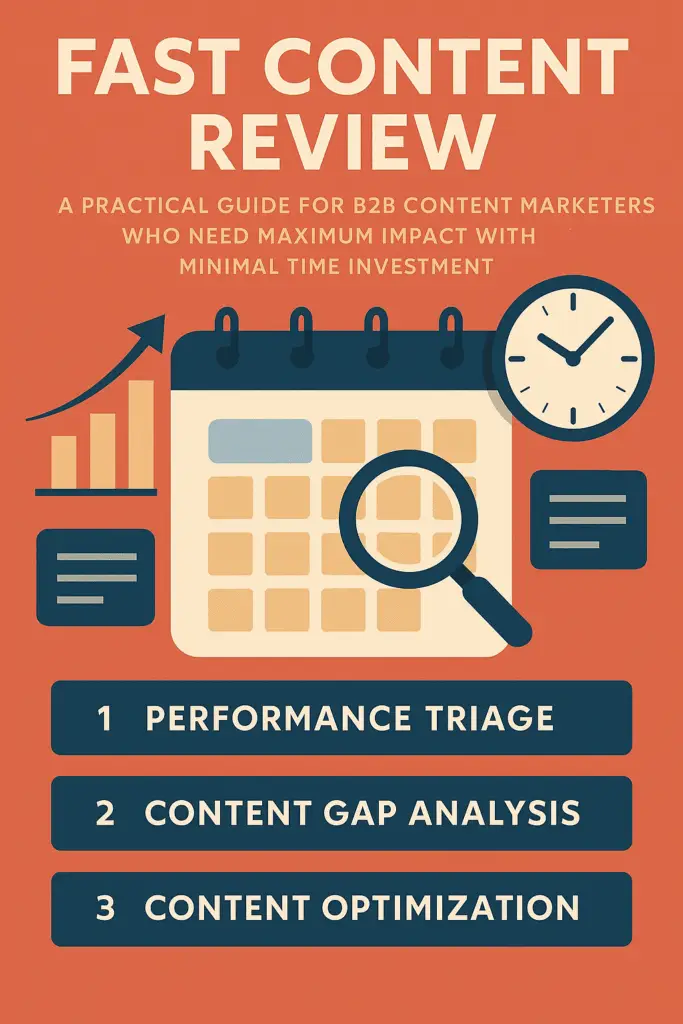A practical guide for B2B content marketers who need maximum impact with minimal time investment
Let’s be honest—the thought of conducting a quarterly content audit probably makes you want to hide under your desk. Between campaign launches, lead nurturing sequences, and that presentation you’re giving next week, who has time for a comprehensive content review?
But here’s the thing: skipping your quarterly content audit is like driving cross-country without ever checking your GPS. You might still reach your destination, but you’ll waste a lot of time and fuel along the way.
The good news? You don’t need to block out entire days or hire a team of analysts to run an effective quarterly content audit. With the right framework and tools, you can complete a meaningful fast content review in under an hour—and actually enjoy the process.

Why Quarterly Content Audits Matter More Than Ever
Before we dive into the how-to, let’s address the elephant in the room: why bother with quarterly reviews when your content calendar is already packed?
The B2B content landscape moves fast. What worked in January might be dead weight by April. Your audience’s pain points evolve, search algorithms shift, and competitors launch campaigns that change the game entirely. A quarterly content audit helps you stay agile and responsive rather than reactive.
Consider this: HubSpot found that companies conducting regular content audits see 40% better performance from their content marketing efforts. That’s not just correlation—it’s the direct result of identifying what’s working, what’s not, and what needs to pivot.
For demand generation managers, this translates to better lead quality and higher conversion rates. For content strategists, it means more strategic decision-making and less guesswork. For agency professionals, it’s the difference between retaining clients and losing them to competitors who are more data-driven.
The 60-Minute Framework: Your Step-by-Step Guide
Ready to transform your approach to content audits? This framework breaks down into four 15-minute segments, each focused on a specific aspect of your content performance.
Segment 1: Performance Triage (15 minutes)
Start with your analytics dashboard—Google Analytics, HubSpot, or whatever platform houses your content performance data. You’re looking for three key metrics from the past quarter:
Top Performers: Identify your top 10 pieces of content by organic traffic, engagement, or lead generation (whichever aligns with your primary goals). These are your content goldmines.
Bottom Performers: Find your bottom 10 pieces by the same metrics. Don’t delete them yet—we’ll address these in segment three.
Traffic Trends: Look for any significant spikes or drops in content performance. Was there a particular month where blog traffic surged? Did your case study downloads suddenly tank in March?
Pro tip: Use your analytics platform’s comparison feature to view quarter-over-quarter performance. This gives you context for whether your content is trending up or down overall.
Segment 2: Content Gap Analysis (15 minutes)
Now shift from looking backward to looking forward. This segment focuses on identifying opportunities and gaps in your current content strategy.
Keyword Gap Analysis: Use tools like SEMrush, Ahrefs, or even Google’s Keyword Planner to identify high-value keywords your competitors are ranking for that you’re not. Look specifically for keywords related to your core business objectives.
Content Format Analysis: Review your content mix. Are you heavy on blog posts but light on case studies? Do you have plenty of top-of-funnel content but nothing for the consideration stage? Map your content to your buyer’s journey and identify obvious gaps.
Competitive Content Review: Pick your top three competitors and spend five minutes each reviewing their recent content. What topics are they covering that you’re not? What formats are they using successfully?
Segment 3: Content Optimization Opportunities (15 minutes)
This is where agile content audits really shine. Instead of overhauling everything, you’re identifying quick wins that can boost performance with minimal effort.
Update Outdated Content: Look for pieces published 6-12 months ago that are still driving traffic but may need refreshing. Update statistics, add new examples, or expand sections that are performing well.
Improve Underperforming Content: Remember those bottom performers from segment one? Many can be rescued with simple improvements like better headlines, updated meta descriptions, or additional internal linking.
Content Repurposing Opportunities: Identify your top-performing content that could be repurposed into new formats. That popular blog post might make an excellent webinar, infographic, or email series.
Segment 4: Strategic Planning and Next Steps (15 minutes)
The final segment is about translating insights into action. This is where your quarterly content audit becomes a strategic planning session.
Priority Content Calendar: Based on your gap analysis, identify 3-5 content pieces to create in the next quarter. Focus on topics that address gaps while building on your strengths.
Optimization Task List: Create a prioritized list of existing content that needs updates or improvements. Aim for quick wins that can be completed within the next 30 days.
Performance Benchmarks: Set specific, measurable goals for the next quarter based on your current performance. If your blog traffic grew 15% this quarter, can you achieve 20% next quarter?
Tools That Make Fast Content Reviews Possible
The right tools can dramatically reduce the time needed for your quarterly content audit. Here are the essentials:
Analytics Platforms: Google Analytics 4, HubSpot, or Mixpanel for performance data. Set up custom dashboards that display your key metrics at a glance.
SEO Tools: SEMrush, Ahrefs, or Moz for keyword research and competitive analysis. Many offer templates specifically designed for content audits.
Content Management: Tools like CoSchedule, ContentKing, or even a well-organized Google Sheet to track content performance and optimization tasks.
Automation: Zapier or similar platforms can automatically pull performance data into spreadsheets, saving valuable minutes during your audit.
Making Agile Content Audits Part of Your Routine
The beauty of this streamlined approach is that it’s sustainable. An hour every quarter is manageable, even for the busiest content teams. But consistency is key to making this work.
Calendar Blocking: Schedule your quarterly content audit like any other important meeting. Treat it as non-negotiable time with yourself and your strategy.
Template Creation: Develop a standard template or checklist that you can reuse each quarter. This eliminates decision fatigue and ensures you don’t skip important steps.
Team Involvement: If you work with a team, consider making this a collaborative 60-minute session. Different perspectives can uncover insights you might miss working alone.
Common Pitfalls to Avoid
Even with the best intentions, it’s easy to derail your fast content review. Here are the most common mistakes and how to avoid them:
Analysis Paralysis: Don’t try to audit every piece of content you’ve ever created. Focus on the past quarter and your most important content pieces.
Perfectionism: The goal isn’t to create the perfect content audit—it’s to create an actionable one. Better to have a good audit that gets implemented than a perfect one that sits ignored.
Scope Creep: Stick to the 60-minute timeframe. If you find yourself going down rabbit holes, note them for future investigation but don’t let them derail your current session.
Measuring Success: What Good Looks Like
How do you know if your quarterly content audit is working? Look for these indicators in the months following your audit:
Improved Content Performance: Your top-performing content should maintain or improve its performance, while previously underperforming content should show measurable improvement.
More Strategic Content Creation: Your new content should align more closely with identified gaps and opportunities.
Faster Decision-Making: When content questions arise, you should have data-driven answers rather than gut feelings.
Your Next Steps
Starting your first quarterly content audit might feel overwhelming, but remember—you’re not aiming for perfection. You’re aiming for progress and actionable insights that improve your content strategy.
Begin with your next quarter. Block out 60 minutes in your calendar, gather your analytics data, and work through the four-segment framework. You’ll be surprised how much clarity you can gain in such a short time.
The most successful content marketers aren’t necessarily the ones who create the most content—they’re the ones who create the most effective content. Regular quarterly content audits ensure you’re always in the latter category.
Your content strategy is too important to operate on autopilot. Sixty minutes every quarter isn’t just an investment in better content—it’s an investment in better results, clearer strategy, and more confident decision-making.
Ready to transform your content audit from a dreaded task into a strategic advantage? Your next quarterly review is just an hour away.
